
The HP VR Backpack G2 doubles as a ‘super-slim’ desktop for ‘intensive design work’ and VR content creation
HP has launched its second-generation HP VR Backpack, which promises a ‘free-roam’ tetherless VR experience and doubles up as ‘super-slim’ desktop for ‘intensive design work’ and VR content creation. The wearable PC is specifically designed to tackle VR engines including Unreal and Unity.
The HP VR Backpack G2 is powered by 8th Gen Intel Core i7 CPU and Nvidia GeForce RTX 2080 GPU.
The G1 edition was built around the Quadro P5200, so the move to the consumer-focused GeForce RTX 2080 is significant and presumably intended to bring down cost.
Normally, GeForce means professional users miss out on ISV-certifications but, surprisingly, HP says its VR Backpack G2 is certified for ‘demanding apps like VRED and Revit’.
We imagine ISV certification is for select products and doesn’t extend anywhere near as far as Quadro. In addition, HP does not call this a workstation, like it did the G1 edition. However, certification on a GeForce-based system does blur the boundaries between consumer and professional.
As one would expect, the GeForce RTX 2080 delivers an increase in performance and HP says the HP VR Backpack G2 offers 25 percent more powerful graphics over the previous generation. However, there is a trade off in GPU memory, with the GeForce RTX 2080 only offering 8GB, half that of the 16GB Quadro P5200. This shouldn’t be an issue for 3D games but for demanding professional workflows, such as automotive, where large datasets are prevalent, this looks to be a significant step back.
The HP VR Backpack G2 is expected to be available this summer for a starting price of $3,299. The wearable PC also offers improved ergonomics, battery management and ease of movement.






